
Foreword

The crypto market is set for exciting growth in 2025, with new developments in blockchain, the rise of stablecoins, and the increasing use of AI. Over time, cryptocurrencies have become more mainstream, attracting attention from banks, financial institutions, and even governments. Bitcoin, in particular, has moved beyond speculation and is now recognized as a valuable asset in both digital and traditional markets.
One of the most significant changes we’re seeing is the rise of stablecoins, reshaping global transactions. By bypassing outdated systems like SWIFT, stablecoins are making cross-border payments faster, cheaper, and more efficient. This trend is already gaining momentum and could significantly impact the financial world.
Another significant milestone was the approval of Bitcoin ETFs in 2024, which has brought in more investments and helped establish Bitcoin as a reliable and stable asset. However, there are still challenges, especially in Europe, where regulations like MiCA have made it harder for businesses to thrive, pushing them to look for friendlier environments.
On the tech side, AI is helping to make crypto more efficient, especially in decentralized finance (DeFi), and improving user experiences across platforms. Innovations in wallets, cross-chain technology, and overall user accessibility are mainstreaming crypto.
In this report, we’ll look at the key trends shaping the crypto world in 2025—from Bitcoin’s growth to the return of DeFi. Whether you’re an investor, a financial professional, or just interested in crypto, understanding these changes will be key to taking advantage of the opportunities ahead.
Crypto Market Predictions 2025
- 10% of Global Population Will Own Crypto in 2025
- Crypto Market to Reach $6 Trillion in 2025
- The U.S. Will Dominate Global Crypto Economy
- Europe’s Crypto Footprint Plummets Due to Regulatory Chokeholds
- El Salvador, UAE, and Hong Kong Will Take the Lead Over EU
- Ethereum Will Be Dethroned as the Biggest Altcoin
- TradFi and Defi Convergence Accelerate
- AI Will Manage 25% of DeFi Assets
Ten percent of Global Population Will Own Crypto in 2025
Cryptocurrency adoption will reach 800 million people by the end of 2025. In 2024, there were 560 million crypto owners (up from 420 million in 2023 – 34% growth), with North America accounting for 72 million. With the U.S. having a pro-crypto administration, over 100 million Americans could own crypto yearly.
That said, following a similar growth pattern in 2025 due to a potential bull cycle, the market could see around 800 million crypto owners (or roughly 10% of the global population).
Some nations, such as Germany, Brazil, or the Czech Republic, are interested in following El Salvador’s example of integrating Bitcoin into their reserves to hedge macroeconomic risks and strengthen institutional momentum.
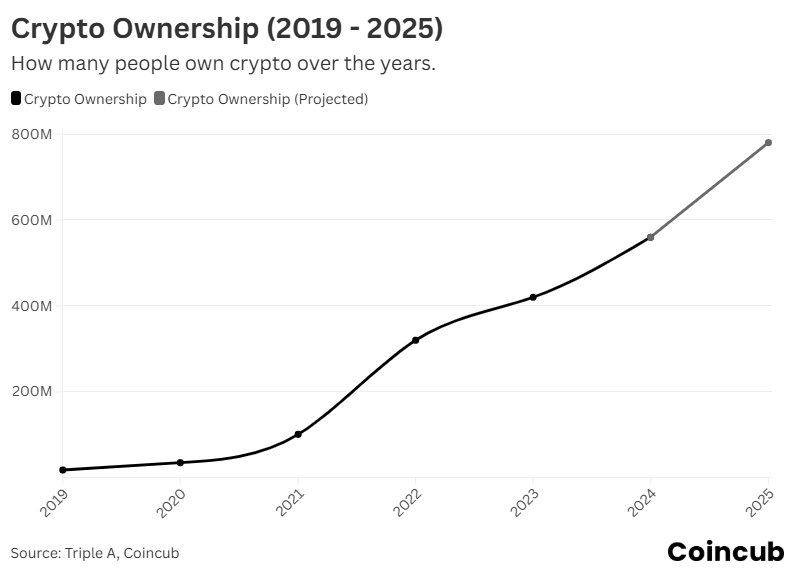
Stablecoin Adoption
Stablecoins enable low-cost, instant cross-border payments. In volatile economies, they provide stability crucial to both traditional and decentralized finance (DeFi) markets. Corporations now use stablecoins to hedge against FX risk and simplify treasury functions. This year, daily stablecoin transactions could reach $300-400 billion, with USDT and USDC leading the market.

Selva Ozelli explained, “President Donald Trump issued an executive order titled “Strengthening American Leadership in Digital Financial Technology.” The EO supports the responsible growth and use of digital assets, blockchain technology, and related technologies across all sectors of the economy to secure America’s position as the world’s leader in the digital asset economy, driving innovation and economic opportunity. The EO focuses on Stablecoins instead of Central Bank Issued Digital Currencies.
For the past 10 years, stablecoins have been one of the fastest-growing areas in digital assets, which is impacting the digital asset ecosystem as well as the world financial system as a whole, with a market projected to reach $3 trillion within the next five years capturing a larger share of the digital asset market, maybe even surpassing traditionally dominant assets like BTC and ETH.
The Middle East and North Africa (MENA) region, with Türkiye stablecoins trading volume as a percentage of GDP, is leading in the world by a significant margin. Backing stablecoins with real-world assets, particularly U.S. Treasuries, has contributed to this success. Unless world regulators ban stablecoins, countries with a regulatory framework, favourable government initiatives, and Web3-friendly policies will continue innovating stablecoins collateralized by a broader range of financial instruments such as fiat currencies, commodities, digital assets, and US Treasuries. So far, the EU, Japan, UAE, and Russia have finalized stablecoins regulations, and world financial market behemoths like the US, UK, and Hong Kong have proposed stablecoins regulations. This year, we will likely see other countries implementing stablecoins legislation.”
DeFi Growth Drives Self Custody
The DeFi boom is accelerating the adoption of self-custody wallets, which give users more control of their digital assets. Account abstraction, gasless transactions, and social recovery improve blockchain accessibility. These advancements simplify user engagement with DeFi platforms by removing intermediaries. Wallet infrastructure is evolving to support borrowing, lending, and staking.
ETF Expansion for Major Cryptocurrencies
The success of Bitcoin and Ethereum ETFs in 2024 has driven institutional demand for ETFs tied to other cryptos. Solana, XRP, and Dogecoin ETFs are under regulatory review. Major firms like Grayscale and VanEck have expanded ETF filings, indicating sustained interest. Spot ETFs simplify crypto investment by eliminating direct custody challenges and promoting institutional inflows. Even Bitcoin maxis are jumping on board, with PlanB recently revealing that he has moved all his Bitcoin from self-custody into a spot Bitcoin ETF (with significant backlash from the community, though).
User Experience Innovation Lowers Entry Barriers
Crypto’s user experience is one of the greatest barriers to mass crypto adoption. However, new advancements like Jack Dorsey’s Bitkey are changing that fast. AI-powered wallets, session keys, and cross-chain interoperability simplify complex operations. Features like gasless transactions and account abstraction reduce the need for technical expertise. AI agents automate asset management tasks such as staking and yield optimization, improving accessibility for beginners and streamlining operations for experienced users.
Web3 Gaming and Onboarding
Gaming is one of the largest entertainment industries in the world. Although 93% of the first round of projects are dead, Web3 gaming is still evolving. There is a clear correlation between gamers and crypto-savvy individuals, and the number of gamers entering the crypto space due to Web3 gaming is expected to resurge in 2025. With new games and platforms emerging, Web3 gaming will play a significant role in onboarding, especially young people.
Crypto Market to Reach $6 Trillion in 2025
The global cryptocurrency market capitalization is projected to surpass $6 trillion by the end of 2025, driven by institutional investments, stablecoin adoption, and real-world asset tokenization. The growing participation of traditional financial institutions, sovereign wealth funds, and major corporations is accelerating capital inflows, further solidifying crypto’s role in global finance.
Bitcoin Price to Hit $180,000 this cycle
Bitcoin’s price is projected to reach $180,000 by the end of 2025, driven by strong inflows into spot Bitcoin ETFs and increased institutional adoption. This surge is primarily fueled by spot ETFs approved in 2024, which have absorbed over 1.5 million BTC (or 8% of the supply), eliminating custody barriers and attracting significant capital from firms like BlackRock and Fidelity.
Institutions increasingly view Bitcoin as a strategic asset, particularly as concerns over currency risks rise. As a result, Bitcoin’s dominance in the crypto market has grown to 60%, up from under 50% in 2023.
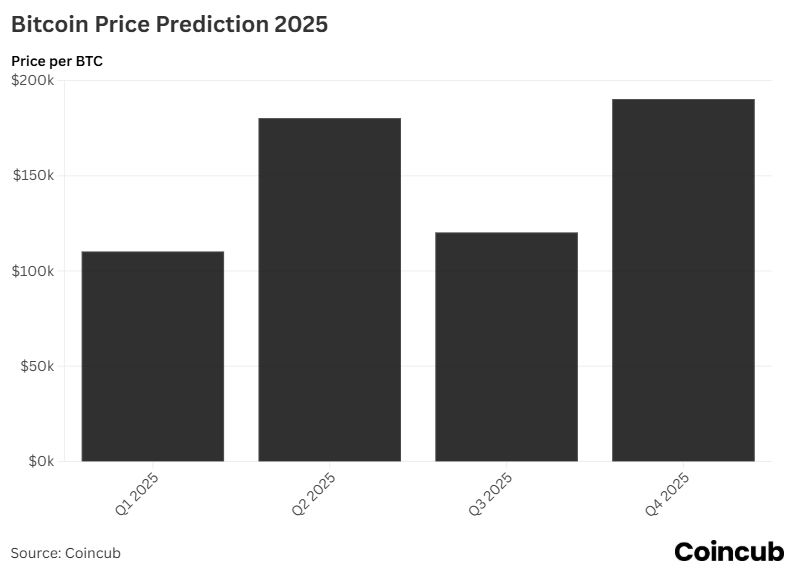
Institutional allocations are expected to double, with national treasuries considering Bitcoin as a strategic reserve. Analysts predict prices between $125,000 and $300,000, while bullish estimates, based on larger portfolio allocations, exceed $700,000.
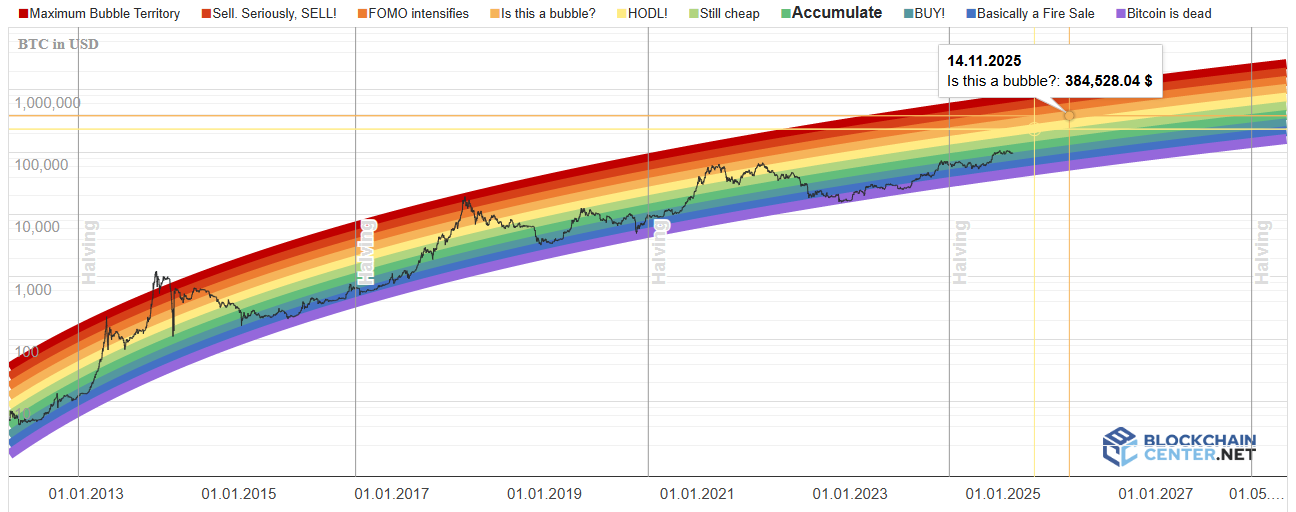
Stablecoins Will Settle up to $400 Billion in Daily Transactions
Stablecoins’ projected market cap will exceed $300 billion in 2025. USDT and USDC lead adoption in corporate payments, cross-border transactions, and remittances. Stablecoins disrupt traditional money transfers by offering lower fees and faster settlements. However, new players might emerge, as new U.S. regulations require strict 1:1 USD reserves for stablecoins. Europe ousted USDT after asking for Tether to hold at least 30% of reserves in low-risk EU-based commercial banks.
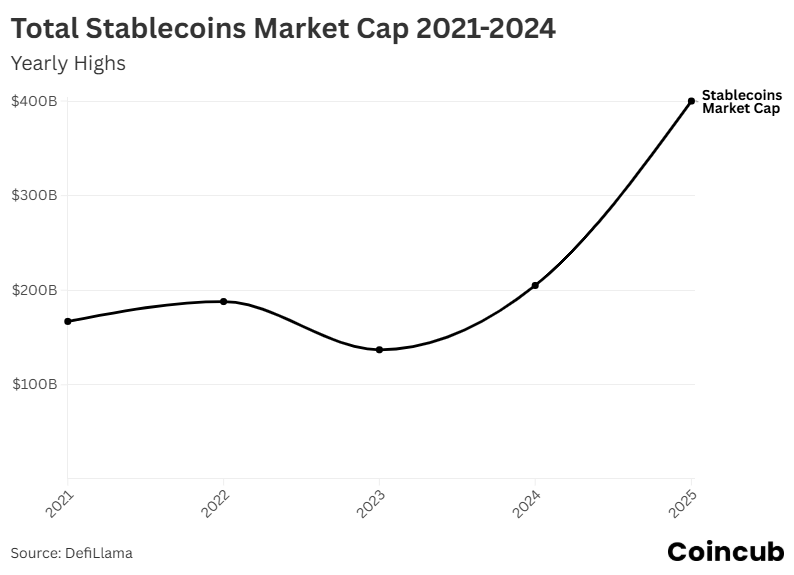
Tokenized Real-World Assets (RWAs) to Exceed $100 Billion
The tokenization of assets like real estate, corporate bonds, and government securities expands liquidity and fractional ownership opportunities. The tokenized RWA market is projected to exceed $100 billion in 2025. Blockchain reduces transaction times and costs, facilitates new funding mechanisms, and increases uptime. Blackrock’s Larry Fink declares tokens “the next generation for markets.” Real estate leads tokenization initiatives for now, providing access to previously illiquid investments.
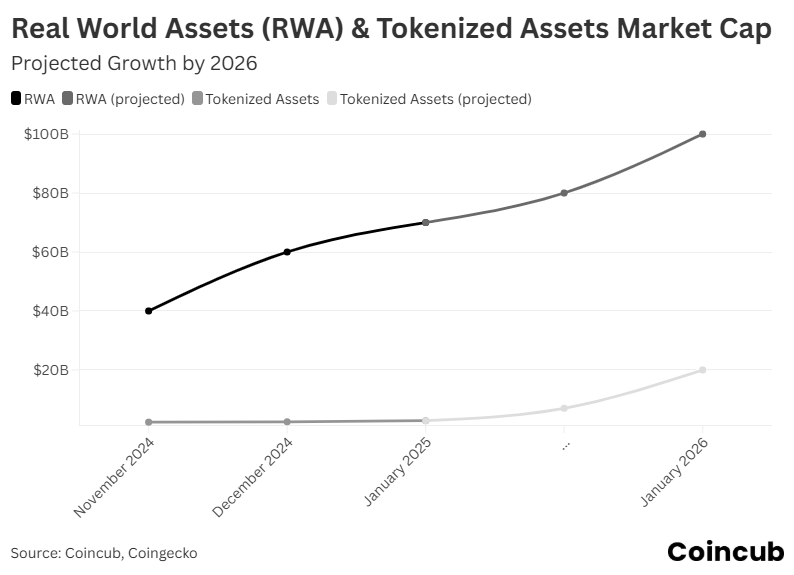
Web3 Gaming to Become an $80 Billion Industry
Web3 gaming is projected to reach $80 billion by the end of 2025, driven by play-to-earn models, decentralized governance, and asset interoperability. Platforms like Portal Coin enable cross-game trading of digital assets, enhancing user engagement. Game studios are adopting blockchain to provide player-owned economies. DAOs now manage significant game treasuries, allowing player-driven governance. Scalability and regulatory hurdles remain, particularly under MiCA. However, Web3 gaming remains critical to onboarding new crypto users.
Solana Price Could Reach $500
Solana’s price is projected to reach $500 by the end of 2025, driven by scalability improvements and institutional demand following ETF approvals. The Firedancer upgrade has increased network throughput and reduced transaction fees. Solana is attracting institutional capital through DeFi platforms and ETFs, positioning it as a strong competitor to Ethereum.
Memecoins Will See Continued Speculation
Memecoins like Dogecoin and Shiba Inu remain relevant due to strong community engagement. Developers are expanding their use by integrating memecoins into DeFi and payment systems.
Regulatory scrutiny and “pump-and-dump” concerns persist. Long-term viability depends on sustained utility and ecosystem growth.
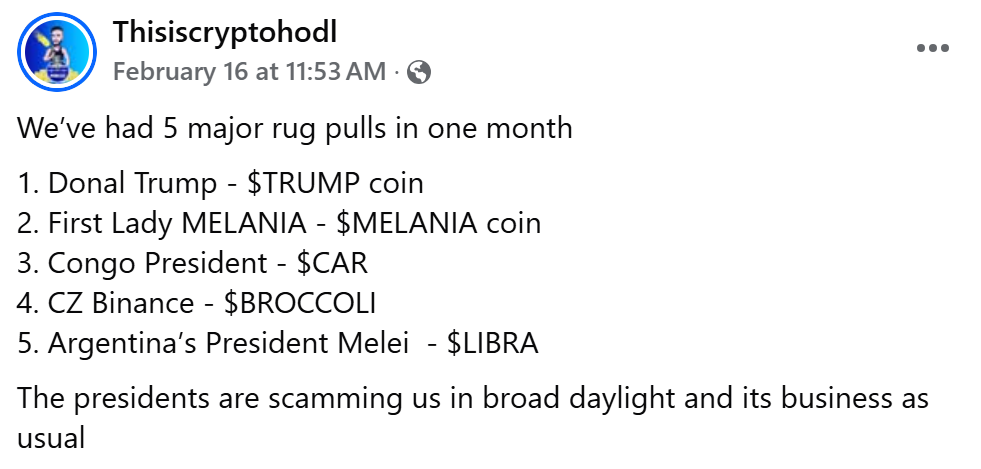
The U.S. Will Dominate Global Crypto Rankings – The Trump Effect
Due to President Trump’s pro-crypto policies, the U.S. will dominate the global cryptocurrency market in 2025. Even during Joe Biden’s presidency under regulatory pressures like “Chokehold 2.0″, the United States was massive for crypto. In 2023, the US captured 30% of global crypto profits, earning $9.36 billion—more than the following nine countries combined and seven times the UK’s $1.39 billion.
It now dominates with 30,000 Bitcoin ATMs (80% globally), 13,251 Bitcoin nodes (27.46%), 40% of Bitcoin mining, 18,000 blockchain jobs, and 300+ universities producing top talent. By year-end 2025, U.S.-based crypto projects are projected to control 60% of global liquidity, up from 40% in 2024.
Pro Crypto Regulation and ETFs Boosting U.S. Crypto Dominance
The GENIUS Act requires 1:1 USD reserves for stablecoins and bans algorithmic variants like TerraUSD. This and the SEC’s policy rollback have spurred over $50 billion in institutional inflows. BlackRock’s IBIT ETF holds over 550,000 BTC, while Solana and XRP ETFs are nearing approval.
The government is exploring a plan to convert 207,000 seized BTC into a national strategic reserve, mirroring efforts in Texas. U.S.-based stablecoins like USDC process $400 billion daily, displacing plans for a U.S. CBDC. The private sector now dominates domestic and international payment systems.
The Rise of Presidential Memecoins
Memecoins have become tools for political finance and decentralized liquidity. In January 2025, Trump launched the $TRUMP token, which peaked at a $15 billion market cap. Politically aligned tokens now hold 12% of DeFi liquidity pools, integrating staking and yield-farming mechanisms.
The SEC has raised concerns about manipulation and “pump-and-dump” risks linked to AI-generated memecoins. Despite this, memecoins continue to attract speculative capital and shape U.S. market dynamics.
Cross-Border Stablecoin Remittances Surge
Stablecoins provide faster, cheaper, and more transparent cross-border transactions. The U.S.-Mexico remittance corridor, one of the world’s largest, has seen stablecoin remittances exceed $500 million monthly, with fees averaging 0.5%—a fraction of the 6.5% charged by traditional services like Western Union. This shift has the potential to save migrant workers and businesses billions annually, increasing financial inclusion for millions.
Corporations like SpaceX have adopted stablecoins to mitigate foreign exchange risks. Despite their advantages, stablecoins face increasing regulatory scrutiny and compliance hurdles. The OECD’s Crypto-Asset Reporting Framework (CARF), signed by the UK, USA, Canada, and most EU member states, requires crypto service providers to share transaction data across 48 jurisdictions to combat money laundering and tax evasion.
U.S. Bitcoin Mining Expansion
The U.S. leads global Bitcoin mining, with significant operations in Texas and Pennsylvania. The 2024 halving reduced block rewards to 3.125 BTC, pushing miners to increase efficiency and sustainability. Over 60% of U.S. mining now uses renewable energy sources.
Texas is a mining hub due to its deregulated power grid and abundant energy resources. Large mining firms like Riot Platforms and CleanSpark are scaling operations to capture half the global hashrate by late 2025.
Ethereum’s Decline and the Role of World Liberty Finance (WLF)
Ethereum is losing market share as institutions shift to Bitcoin ETFs and faster networks like Solana. High transaction fees and network congestion limit its large-scale adoption. Layer-2 solutions improve scalability but fragment liquidity, reducing overall efficiency.
World Liberty Finance (WLFI), a Trump-affiliated initiative, holds 20,000 ETH and $200 million in Bitcoin-backed loans to support Ethereum’s relevance. To this end, WLF proposes an ETF offering a 6.5% staking yield, which could attract significant institutional inflows.
Europe’s Crypto Footprint Plummets Due to Regulatory Chokeholds
The Markets in Crypto-Assets (MiCA) regulation has sharply diminished Europe’s role in the global cryptocurrency market. MiCA prioritizes compliance over innovation, driving startups, developers, and capital to more favorable jurisdictions.
Europe risks becoming irrelevant in the projected $6 trillion global crypto economy.
Regulatory Overreach and Industry Collapse
MiCA enforces high capital and compliance requirements for crypto asset service providers (CASPs). Firms must hold €50,000 to €150,000 reserves and comply with strict transaction caps.
This has triggered a 99.5% decline in European crypto-licensed companies (Virtual Asset Service Providers or VASPs). There were 2,700 VASPs in December 2024.
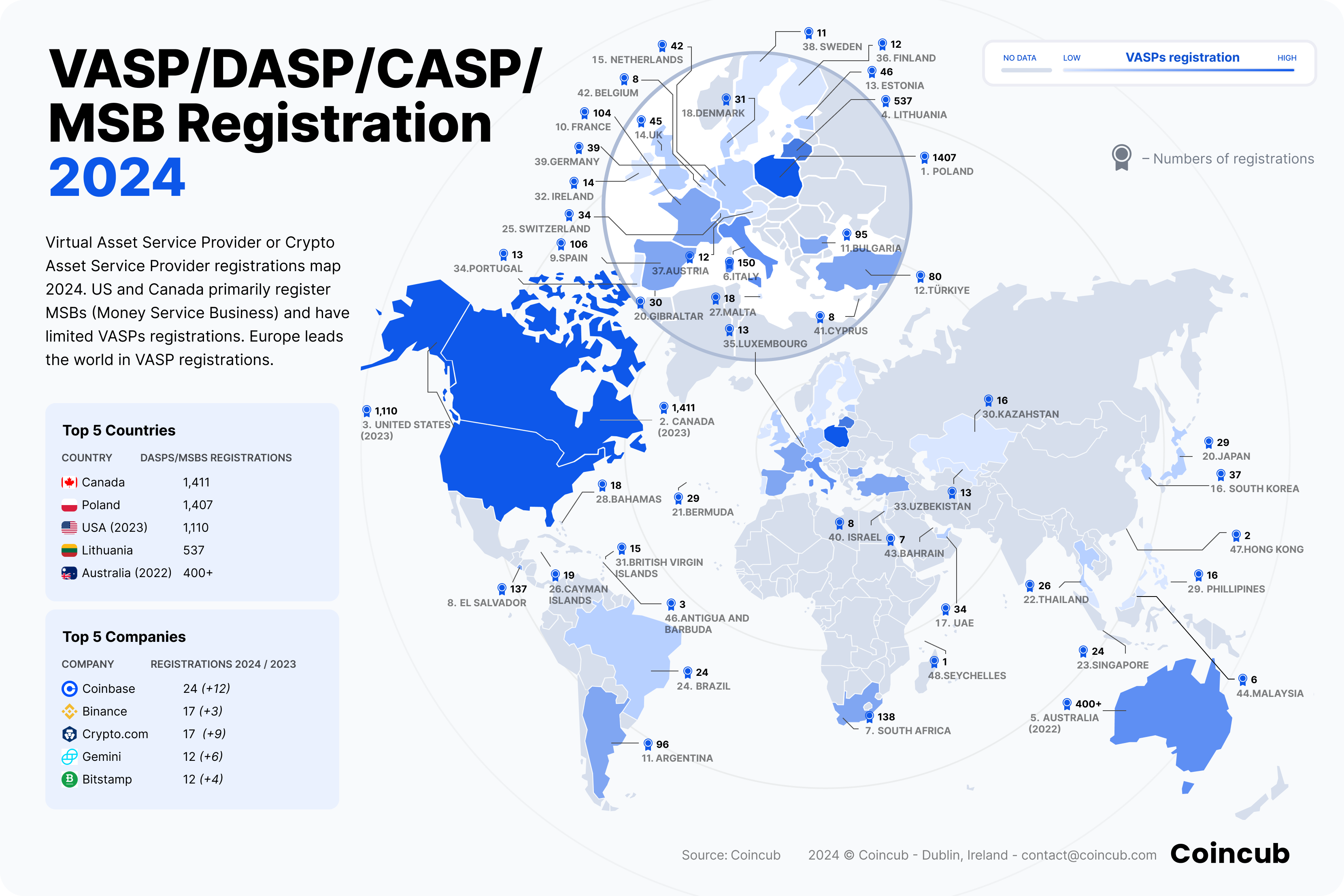
As of February 2025, only 11 licensed CASPs (Crypto Asset Service Providers) are in the EU. This number is projected to reach around 130 CASPs, but this reduction is still alarming and a cause for concern for the ECB and the EU crypto sector.
|
MoonPay Europe B.V. |
NL |
|---|---|
| BitStaete B.V. | NL |
| Zebedee Europe B.V. | NL |
| Hidden Road Partners CIV NL B.V. | NL |
| Boerse Stuttgart Digital Custody GmbH | DE |
| Bitpanda Asset Management GmbH | DE |
| Crypto Finance (Deutschland) GmbH | DE |
| OKCoin Europe Limited | MT |
| BP23 CA Limited | MT |
| Foris DAX MT Limited | MT |
| ZillionBits Limited | MT |
Source: https://www.esma.europa.eu Last update: 14 February 2025
Talent and Capital Outflow
Europe’s restrictive regulations are driving talent and capital to crypto-friendly regions. Post-election U.S. policies pull developers to Texas and Florida with high salaries and investment opportunities. UAE attracts talent through its 10-year web3 talent visa. Compliance costs are bankrupting decentralized finance (DeFi) projects, turning Europe into a “startup graveyard.”
ECB’s Anti-Crypto Stance and Its Impact on Traditional Finance
The European Central Bank (ECB) has intensified anti-crypto policies, labeling Bitcoin a tool for illegal activity. Meanwhile, the ECB is advancing a central bank digital currency (CBDC) with limited privacy features to counter U.S.-based stablecoins like USDC. Additionally, the ECB has rejected proposals for national Bitcoin reserves.
Decline in Crypto-Related Jobs and Academic Programs
The regulatory crackdown is causing a sharp decline in Europe’s blockchain-related job market. Crypto jobs are projected to decrease by 50% in 2025, with thousands of roles disappearing in key economies such as Germany and France.
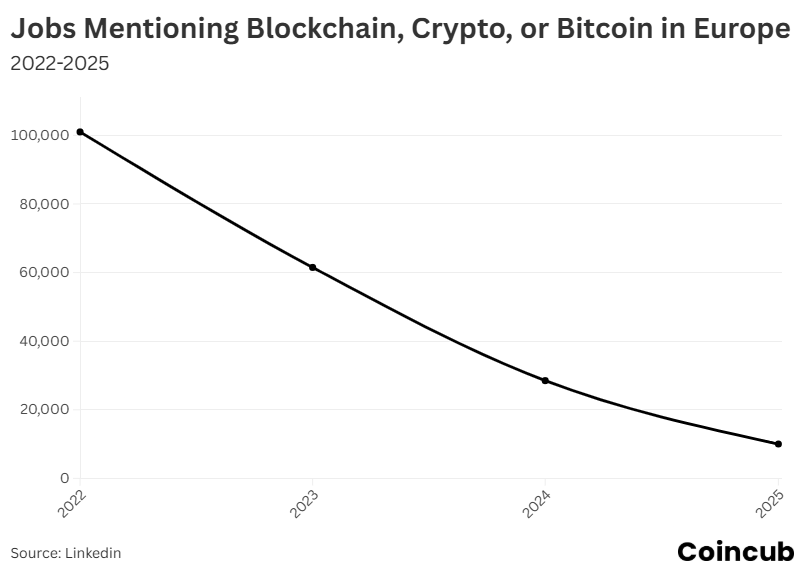
Germany has seen a mass exodus of Web3 talent since companies moved offshore despite increased crypto adoption. Jobs in the Web3 sector went from more than 2,500 in 2021 to less than 1,000 in 2025. The same trend is evident in other EU countries.
Strategic Risks and the Need for Reform
MiCA’s rigid enforcement makes it impossible for Europe to compete in emerging technologies like blockchain-integrated AI and quantum-resistant cryptography. While the U.S. and Asia prioritize risk-tolerant capital and applied research, Europe’s focus on compliance limits growth and innovation.
The EU must revise MiCA to balance oversight with innovation to reclaim its standing, similar to how it reverted its stance on AI.
El Salvador, UAE, and Hong Kong Lead Over the EU
Emerging crypto hubs attract capital and talent as Europe stifles innovation and decimates its crypto economy. These regions balance oversight with growth.
El Salvador’s Crypto Leadership
El Salvador has emerged as a leading global crypto hub, captivating the attention of enthusiasts and businesses worldwide; under the visionary leadership of President Nayib Bukele, the country made history by adopting Bitcoin as a legal tender and establishing the first national Bitcoin reserve.
Building on its zero-tax policy for crypto income and capital gains, El Salvador has launched initiatives to boost tourism, enhance financial inclusion through Bitcoin adoption, and invest in Bitcoin education programs.
With the recent deal with IMF, requiring Bitcoin to be optional for businesses rather than mandatory, El Salvador has remained committed to its crypto agenda.
Most recently, Tether established its global headquarters in San Salvador and discussed the construction of a 70-story skyscraper after obtaining a Digital Asset Service Provider license from the National Commission for Digital Assets (CNAD).
The UAE’s Rise as a Crypto Tax Haven
The UAE offers a 0% crypto tax and streamlined regulations. Crypto Asset Service Providers (CASPs) relocating from Europe benefit from lower compliance costs in Dubai and Abu Dhabi. Regulatory initiatives, including the government’s exploration of a dirham-pegged stablecoin, promote blockchain experimentation across sectors like fintech and real estate.
Hong Kong’s Strategic Adaptation to Global Crypto Trends
Hong Kong has quickly recognized that Bitcoin has become a new battleground between China and the US and that crypto can help “stimulate the sluggish global economy.” Hong Kong legislator Johnny Ng Chong called for lawmakers in the special administrative jurisdiction to follow the US in researching the feasibility of a federal Bitcoin reserve with the help of Mainland China.
Honduras Próspera
On January 21, 2025, Próspera announced that it had received a $150 million strategic investment from Coinbase Ventures. This partnership underscores the deep alignment between the mission and vision of both organizations: to unleash human potential through economic freedom.

“Where freedom thrives, societies flourish,” says Brian Armstrong.
BRICS Financial Strategy
BRICS nations are incorporating Bitcoin into their financial strategies by planning to allocate up to 5% of national reserves to crypto. This move hedges against geopolitical risks and reduces dependence on the U.S. dollar in global trade.
Türkiye

“Türkiye is among the leading countries in the world in the crypto market due to its citizens’ interest in technology and high inflation. It regulated the crypto market with the regulations it issued in the crypto field in 2024. Due to the high crypto adoption rate, crypto companies’ interest in Türkiye is increasing even more.”
Ethereum Will Be Dethroned as the Biggest Altcoin
Ethereum’s decade-long dominance in the altcoin market will be seriously threatened for the first time in 2025. High transaction costs, scalability issues, and rising competition drive institutional and retail users to alternative networks.
The Decline of Ethereum’s Market Share
Institutions are reducing their exposure to Ethereum due to escalating fees and inefficiencies. Ethereum’s transaction costs are projected to surpass $1 billion, making large-scale operations unsustainable. Layer-2 solutions like Optimism and Arbitrum alleviate some scalability issues but create liquidity fragmentation. Competing networks offer superior scalability and lower costs, attracting institutional capital. Solana, Hedera Hashgraph, and Avalanche provide higher throughput and interoperability, prompting further diversification away from Ethereum. As a result, Ethereum’s market share continues to decline like never before in a bull market.
The Rise of Competitive Blockchain Networks
New blockchain networks are exploiting Ethereum’s limitations. Hedera Hashgraph, supported by corporations like Google and Boeing, focuses on enterprise applications with low fees and instant finality. Solana’s Firedancer upgrade improves scalability and reduces costs, making it attractive to institutional investors through potential ETFs and DeFi platforms. Polkadot’s parachain system enhances cross-chain interoperability, making it a hub for multi-chain liquidity and applications. These networks rapidly gain institutional and retail market share at Ethereum’s expense.
The Role of NFTs in Ethereum’s Decline
Ethereum was once synonymous with NFTs, but not only is there a stark decline in NFT activity now, but platforms like Solana have gained traction due to lower costs. Utility-driven projects like Pudgy Penguins are helping the space by offering real-world benefits, such as merchandise sales. However, Ethereum’s ability to retain this advantage faces growing pressure from competitors with lower fees and enhanced functionality.
Centralization Concerns
The shift to Proof-of-Stake has raised concerns about centralization within the Ethereum network.
A significant portion of staked ETH is controlled by a few large entities, such as centralized exchanges (e.g., Coinbase) and staking pools. Centralization could expose Ethereum to regulatory scrutiny. The SEC claimed that because most of the Ethereum network’s validating nodes are in the United States, the entire network is subject to US securities laws.
Loss of First-Mover Advantage and Tech Legacy
Ethereum was the first blockchain to introduce smart contracts and programmable functionality at scale. However, its first-mover advantage diminishes as competitors adopt more advanced technologies without inheriting Ethereum’s legacy limitations.
For example:
- Newer blockchains are built with scalability in mind from inception.
- Interoperability protocols like Cosmos enable seamless chain communication, reducing reliance on Ethereum as a central hub.
TradFi and DeFi Convergence Accelerates
The line between traditional finance (TradFi) and decentralized finance (DeFi) continues to blur as both systems integrate. DeFi’s transparency, asset control, and disintermediation innovations attract institutional interest.
At the same time, decentralized exchanges (DEXs) are challenging centralized exchanges (CEXs), reshaping the crypto ecosystem.
DEX Expansion and Market Share Growth
DEXs now account for 40% of crypto trading volume, and cumulative transactions are expected to exceed $3 trillion by year-end 2025. Platforms like Uniswap, PancakeSwap, and Raydium offer transparency and user custody, attracting users seeking control over their assets.
Despite this growth, liquidity fragmentation and slippage remain challenges. However, improvements in cross-chain technology and market-making strategies are boosting transaction efficiency.
Declining CEX Usage Amid Regulatory Pressure
CEXs are losing market share due to regulatory scrutiny. Active CEXs fell from 750 in 2022 to 640 in 2024. Market consolidation and compliance costs have exacerbated the decline. KuCoin’s $297 million legal settlement and U.S. exit reflect this trend.
The same is true for Binance, whose market share fell from 44% to 34.7% in 2024 as regulatory demands intensified.
Institutions are shifting to DeFi partnerships, leveraging decentralized liquidity pools to offer crypto-backed products.
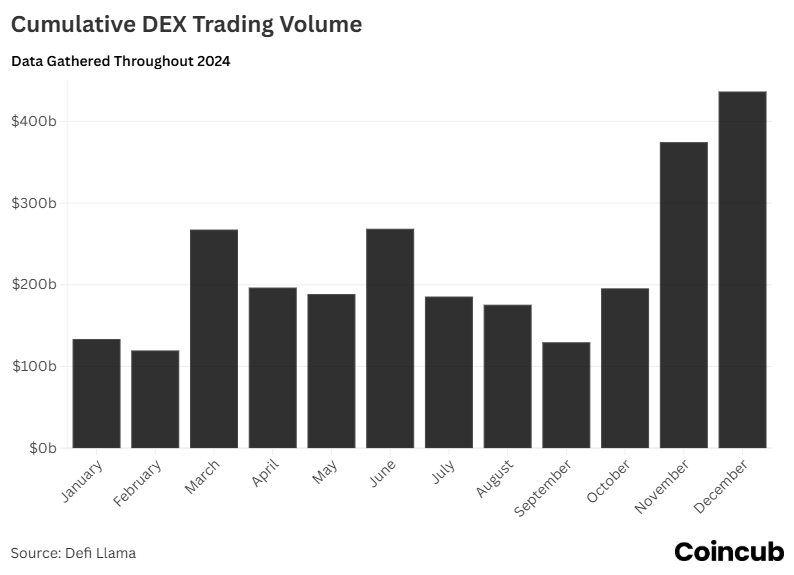
Growth of Bitcoin-Backed Loans
Bitcoin-backed loans are becoming vital in TradFi-DeFi convergence, offering immediate liquidity without asset liquidation. By late 2025, BTC-collateralized debt issuance is projected to surpass $5 billion. These instruments enhance market liquidity and align with asset tokenization trends.
Integration of Banking and Crypto Services
Banks are adopting crypto services like custody and lending, while crypto platforms introduce TradFi products such as derivatives and savings accounts. This convergence accelerates liquidity flow between decentralized and centralized markets. Institutions benefit from DeFi’s transparency and automation, while DeFi platforms leverage institutional capital.
AI Will Manage 25% of DeFi Assets
AI will continue to be the main story in 2025. Last year, AI started transforming DeFi by automating processes and improving efficiency. By the end of 2025, AI agents are expected to manage 25% of DeFi assets.
Their expanding role across trading, compliance, and user interaction will accelerate innovation and adoption.
AI Automation in DeFi
AI agents manage over $100 billion in DeFi activities, such as staking, yield optimization, and liquidity allocation. These agents analyze real-time data to optimize asset positioning across platforms like Lido. AI bots automate trading based on market signals, reducing human emotional bias. They also minimize liquidity fragmentation by routing transactions efficiently across blockchains. AI’s automation enhances DeFi scalability, allowing users to access complex financial services through simplified workflows.
AI-Powered Compliance Becomes Mandatory
As tax and AML enforcement tighten globally, AI tools have become essential for compliance. CASPs must comply with the Common Reporting Standard (CARF), which mandates transaction reporting across 48 jurisdictions.
AI Tax Software like Blockpit automates these processes, easing compliance burdens. Additionally, AI systems enhance AML and KYC enforcement by automating fraud detection and suspicious transaction monitoring.
Web3 compliance differs from traditional finance because it must address decentralization, pseudonymity, and global transactions while meeting legal requirements. AI-powered compliance tools are stepping in to solve these challenges by:
- Automating AML & KYC processes – AI speeds up identity verification (KYC) and transaction monitoring (KYT) without compromising privacy, making compliance more efficient.
- Real-time blockchain monitoring – AI models analyze on-chain activity, instantly detecting suspicious patterns and flagging high-risk transactions.
- Predictive analytics for evolving regulations – AI helps businesses anticipate and adapt to new compliance requirements before they take effect.
- Automating reporting & audits – AI streamlines regulatory reporting, ensuring accuracy and reducing human error in audit preparation.
AI-powered compliance is no longer a competitive advantage—it’s a necessity. Web3 companies must integrate AI-driven solutions now to remain compliant, scalable, and future-proof.
AI Improves User Experience
AI-powered virtual assistants enable users to interact with DeFi platforms and engage with different services through natural language, such as staking or asset swaps. Chatbots guide users through complex operations, and AI agents enhance wallet security by predicting threats and optimizing transaction routing.
AI’s Expanding Influence in Crypto Markets
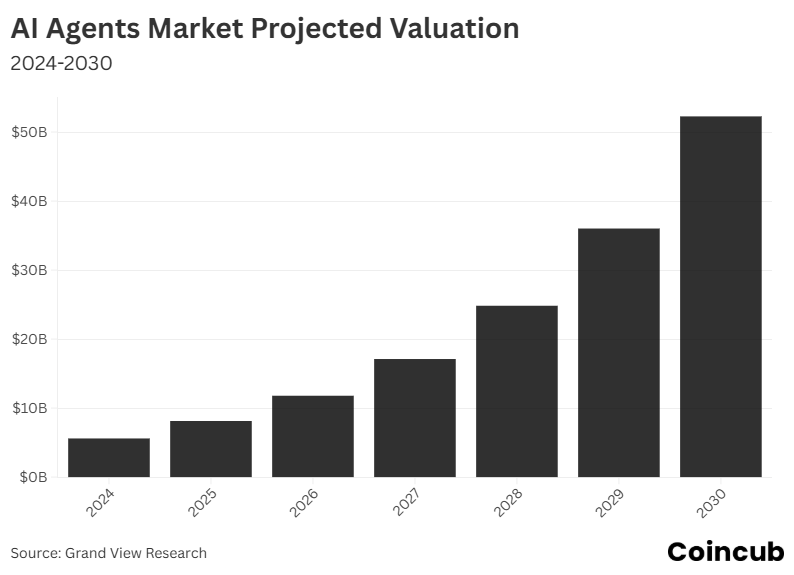
AI-driven solutions have attracted over $10 billion in investment by early 2025, with a projected 45.1% CAGR through 2030. Thousands of AI agents now shape market dynamics by automating liquidity management, asset allocation, and yield strategies. AI also influences speculative markets through algorithm-driven memecoins, driving rapid valuation shifts.

Conclusion
The cryptocurrency market is projected to exceed $6 trillion in 2025, driven by institutional adoption, stablecoin integration, and blockchain advancements. Bitcoin ETFs and tokenization are accelerating capital inflows and reshaping financial infrastructure. The United States is set to dominate global crypto markets through deregulation and strategic initiatives. Emerging hubs like the UAE, Hong Kong, and El Salvador are capitalizing on Europe’s declining competitiveness due to regulatory overreach. Europe’s crypto economy is seriously declining due to MiCA regulations, which have driven startups and capital to crypto-friendly regions. Europe risks permanent exclusion from the global blockchain economy without policy reforms to balance oversight and innovation.
AI agents automate asset management, compliance, and liquidity optimization, while decentralized exchanges gain market share by offering transparency and user control. Traditional financial institutions are adopting DeFi tools to diversify and enhance services. Interoperability improvements and tokenization are expanding blockchain applications across industries.
Blockchain technology will continue to disrupt traditional financial systems. Adoption will grow as scalability and accessibility improve. The success of crypto’s integration into global finance will depend on how effectively stakeholders balance regulatory frameworks with technological progress. The financial world faces a crucial decision: adapt to blockchain-driven transformation or risk irrelevance in the evolving digital economy.
Disclaimer
This is not financial or tax advice. Coincub is an independent publisher. Its articles, interactive tools and other content are provided to you for free, as self-help tools and for informational purposes only. This space changes rapidly and evolves, so please make sure to do your research. Although we do our best to provide you the best information, we cannot promise the accuracy or applicability of any information on this site or regarding your circumstances.






